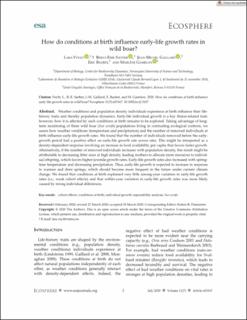| dc.contributor.author | Veylit, Lara | |
| dc.contributor.author | Sæther, Bernt-Erik | |
| dc.contributor.author | Gaillard, Jean Michel | |
| dc.contributor.author | Baubet, Eric | |
| dc.contributor.author | Gamelon, Marlène | |
| dc.date.accessioned | 2022-05-10T11:02:32Z | |
| dc.date.available | 2022-05-10T11:02:32Z | |
| dc.date.created | 2020-07-20T09:36:48Z | |
| dc.date.issued | 2020 | |
| dc.identifier.citation | Ecosphere. 2020, 11 (7), . | en_US |
| dc.identifier.issn | 2150-8925 | |
| dc.identifier.uri | https://hdl.handle.net/11250/2995018 | |
| dc.description.abstract | Weather conditions and population density individuals experience at birth influence their life-history traits and thereby population dynamics. Early-life individual growth is a key fitness-related trait; however, how it is affected by such conditions at birth remains to be explored. Taking advantage of long-term monitoring of three wild boar (Sus scrofa) populations living in contrasting ecological contexts, we assess how weather conditions (temperature and precipitation) and the number of removed individuals at birth influence early-life growth rates. We found that the number of individuals removed before the early-growth period had a positive effect on early-life growth rate across sites. This might be interpreted as a density-dependent response involving an increase in food availability per capita that favors faster growth. Alternatively, if the number of removed individuals increases with population density, this result might be attributable to decreasing litter sizes at high density, leading mothers to allocate more resources to individual offspring, which favors higher juvenile growth rates. Early-life growth rates also increased with springtime temperature and decreasing precipitation. Thus, early-life growth is expected to increase in response to warmer and drier springs, which should become more frequent in the future under current climate change. We found that conditions at birth explained very little among-year variation in early-life growth rates (i.e., weak cohort effects) and that within-year variation in early-life growth rates was more likely caused by strong individual differences. | en_US |
| dc.language.iso | eng | en_US |
| dc.publisher | Wiley | en_US |
| dc.rights | Navngivelse 4.0 Internasjonal | * |
| dc.rights.uri | http://creativecommons.org/licenses/by/4.0/deed.no | * |
| dc.title | How do conditions at birth influence early‐life growth rates in wild boar? | en_US |
| dc.title.alternative | How do conditions at birth influence early‐life growth rates in wild boar? | en_US |
| dc.type | Peer reviewed | en_US |
| dc.type | Journal article | en_US |
| dc.description.version | publishedVersion | en_US |
| dc.source.pagenumber | 10 | en_US |
| dc.source.volume | 11 | en_US |
| dc.source.journal | Ecosphere | en_US |
| dc.source.issue | 7 | en_US |
| dc.identifier.doi | 10.1002/ecs2.3167 | |
| dc.identifier.cristin | 1819821 | |
| dc.relation.project | Norges forskningsråd: 223257 | en_US |
| cristin.ispublished | true | |
| cristin.fulltext | original | |
| cristin.qualitycode | 1 | |

